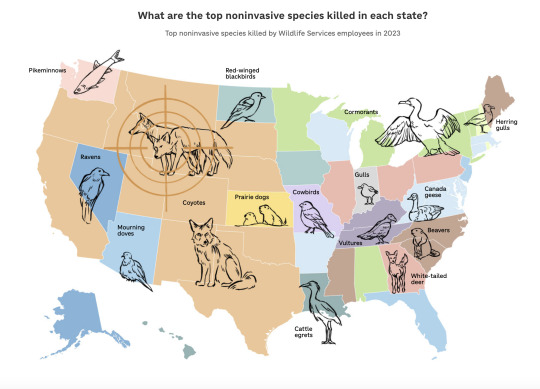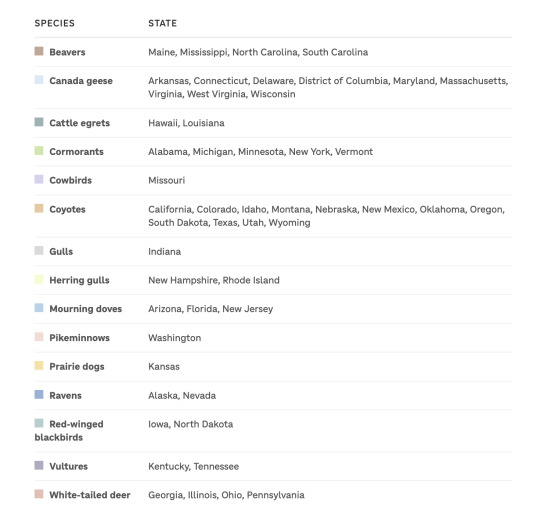#gopher chokers
Explore tagged Tumblr posts
Text
The agency that carries out this "program" is called the Wildlife Services of the U.S. Department of Agriculture. I hate this agency with all the passion I can generate, and have ever since I learned about it and what it does 15 years ago. It exists to murder wildlife, particularly to benefit farmers and ranchers. Long ago, someone put handle on the agency, calling it the "gopher chokers." The name fits. I have done more than a fair amount of yelling to my dead representatives in Congress and senators to dismantle the agency or change its purpose and mission.
My favorite statistic. I don't remember the year, but let's just say 2014. In that year, Wildlife Services killed about 350,000 red-winged blackbirds. Why? They were eating sunflower seeds in sunflower farms. You'd think that a sunflower farmer should be taking that risk rather than causing us taxpayers to make his profit for him, right?
Other stats. We're starting to believe that beavers need to be returned to the wild to help us with floods and drought resistance. Wildlife Services killed 24,603 beavers in 2023. Other stats for death: 525 cardinals; 68,562 coyotes; 430 black bears; 17,109 mourning doves; 6,952 cattle egrets; 1,292 red foxes; 24,744 Canadian geese (even though they are protected by the Migratory Bird Treaty Act); 1,209 jackrabbits (four species of them); 1,981 possum; 905 robins. I could go on, but I'm going to puke. Here's the link to the chart.
Sorry about the length of this post, but it takes a while to describe pure evil.



Excerpt from this story from NPR:
The United States Department of Agriculture's [USDA’s] Wildlife Services program is a holdover from the 1930s, when Congress gave the federal government broad authority to kill wildlife at the request of private landowners. In that era, government-sponsored extermination programs for native wild animals, like wolves and grizzly bears, were common.
After the Endangered Species Act was passed in 1973, federal agencies were required to change course and start helping some of those wild animal populations recover. But today, Wildlife Services employees still kill hundreds of thousands of noninvasive animals a year, data from the agency shows. Even species considered threatened under the Endangered Species Act, like grizzly bears, are not exempt. So long as livestock or human life are threatened, federal rules allow Wildlife Services to kill those animals, too.
Conservationist groups have long protested the program, saying the government is killing animals at the request of private livestock owners without first presenting enough evidence to show that the management methods aren’t harming the environment, as federal law requires.
“One of the biggest issues that comes up with Wildlife Services, and where we've beaten them in court multiple times in multiple states, is the controversy of the science,” said Lizzy Pennock, an attorney for the nonprofit WildEarth Guardians. “We need to get out of the framework of the 1800s and 1900s where it's like, kill any carnivores that might be inconvenient.”
Wildlife Services officials say that with the exception of invasive species, employees only kill wild animals that attack livestock or cause damage. But data obtained by NPR indicates the program often kills native wildlife that didn’t kill or injure livestock.
NPR obtained and digitized thousands of Wildlife Services work orders from Montana, created from 2019 through 2022, and built a database that shows that the program’s employees frequently kill native wild animals without evidence of livestock loss. The documents reveal that during those three years, employees killed approximately 11,000 wild animals on Montana properties where no wildlife was recorded as responsible for killing or injuring any livestock. In those cases, only a "threat" from those wild animals was logged in the records.
The agency frequently used helicopters and planes to shoot large numbers of wild animals at a time, the documents show, a method activists consider cruel and scientists say can lead to local eradications.
Although some livestock organizations financially support part of Wildlife Services' work, individual livestock owners do not pay a fee when federal employees come to their properties. Employees are allowed to kill wild animals on those private areas as well as on public land, like state forests and parks.
“That’s a bloodbath,” said Collette Adkins, a lawyer who leads the Carnivore Conservation program at the Center for Biological Diversity. “That just seems like yahoos with rifles killing everything they see that moves. It’s horrible to imagine the amount of suffering involved there.”
“Of all wildlife encountered in FY 2023, Wildlife Services lethally removed 5.14%, or approximately 1.45 million, from areas where damage was occurring. Invasive species accounted for 74.2% (1,079,279) of the wildlife lethally removed,” a representative wrote.
An NPR analysis of those reports shows that Wildlife Services killed more than 370,000 noninvasive animals across the country in the 2023 fiscal year. And over the past nine years, Wildlife Services killed 30 threatened grizzly bears and at least 1,500 gray wolves in states where they were otherwise supposed to receive protection under the Endangered Species Act, like in Minnesota and Wisconsin.
But the reports don’t reveal the names of the livestock owners that use Wildlife Services. That’s to protect the privacy of people in the agriculture industry, the agency has said. Wildlife Services also doesn’t disclose in those reports how many wild animals were killed by federal employees on public land.
20 notes
·
View notes
Text

Puttin' that old man in Outfits Once More
#gopher art#tf2 medic#this is the result of the workshop adventure I took last night#so of course burly beast but also the bare arms of the Helping Hands + the choker from The Hasslehoffer. bonus shorts that NO ONE HAS MADE#IM SO DISSAPOINTED#im happy with how this looks more or less. But im always annoyed at how inconsistent my art is#it never looks the same and It makes me mad
134 notes
·
View notes
Text
Love The Looney Tunes Show like I deeply appreciate they went all out for this Domestic Roomates au fanfic, they truly didn’t have to go this hard.
Like listen. Daffy Duck had such a hard childhood that he developed Dissociative Amnesia and can’t remember things past the age of 15. He refuses to get in contact with his family, the only relative he has positive memories of was his grandma, who bequeathed to him a pearl choker. He was a loser in high school and was bullied by the head jock, Porky Pig (his memories switched their roles in his head I guess? to cope?) His parents argued and fought to the point Daffy moved out. With nothing to his name, he worked at ungodly hours at Thataburger (aka Whataburger aka he’s Texan) with ambitions so low he just wanted to own a recliner to rest in. He’s insecure, cries himself to sleep every night, is paranoid, has daddy issues (but that’s okay Foghorn Leghorn took him under his wing) and is a compulsive liar. He’s also a former CEO of one of the biggest companies in the TLTS universe, former Marine, member of city council, licensed cosmetologist, the list goes on. The only thing this dude can’t do is go to therapy. Honestly he could improve himself but his roomate™ enables him and kinda. needs him to be fucked up. so his own life isn’t boring?
And the overly polite gophers run an antique shop, that’s so adorable
#you sittin there yakkin (talk tag)#the looney tunes show#looney tunes#It’s just. I’m fascinated that the show exists#they created a traumatic backstory for Daffy Duck. they made lore for Daffy Fucking Duck#don’t talk to me unless you can list every job daffy’s ever had smh
498 notes
·
View notes
Text
Character References
Metal Family / Inside Job AU
-
Dee
5ft 7in / 30 years old
curly blond hair that reaches mid-back, usually kept in a low ponytail with loose strands
a white lab coat over a grey button-down
black ripped jeans with an especially ripped knee and a chain
black lace-up boots that reach just below his knee
black spiked choker and matching bracelets
black nails, black eye makeup atop dark eye circles, pierced ears, occasionally a light beard or some stubble

-
Heavy
6ft 3in / 28 years old
stylistically messy russet hair that reaches the end of his shoulder blades, with a few thin braids in the underside
an old, black leather jacket
a black button-down with a copper tie
black slacks and red converse
black wrist cuffs / bracelets and a few rings on each hand, including a college ring
two piercings on each eyebrow, a bellybutton piercing, and a piercing in each earlobe, all silver

-
click "keep reading" for the rest of them :3
Dr Lif
5ft 7in / 31 years old
black, shiny, sleek, sometimes messy hair that reaches her lower back
a white lab coat with large pockets on the inside
dark eye makeup, a black spiked choker, black leather bracelets, beaded bracelets, and black nails
a black silk button-down shirt, halfway unbuttoned to reveal a black lacy bra
black shorts with a belt, chains, & a thigh garter/harness attached to the right thigh
black thigh highs and garters with chains
black knee-high lace-up boots

-
Diana
5ft 4in / 32 years old
straight pale pink hair that reaches just past her shoulders
a white suit jacket with sleeves rolled up to the elbow and a pink leopard print cami top underneath
white mini pencil skirt atop black tights
light pink platform Pumps
black winged eyeliner, mauve eyeshadow and lipstick, gold necklaces and bracelets, pink nails with a white ring finger

-
Lydia
5ft 8in / looks 35
curly blonde hair with blue, pink, and purple streaks, that reaches just past her shoulders – usually loose but occasionally in a ponytail or messy bun
a pale blue silk party dress with matching pale blue heels that have ribbons adorned with butterflies reaching mid-calf
crystal jewelry and a necklace with mushroom shaped beads
sparkly purple eyeshadow, white body glitter, and iridescent pale blue painted nails

-
Gopher
5ft 5in / early to mid 60s
brown hair shaved into a buzz cut
a red beanie with holes provided for his gopher ears
camo cargo pants
an ICP shirt hidden underneath his military uniform
white Supreme sneakers with red laces

-
Glam
6ft / mid 50s
upper-back length blond hair, always wildly messy and usually kept in a low, loose ponytail (it is never spiky like Glam's hair usually is when he's happy.)
a black house-robe
pink sweatpants with a white stripe down the leg
black hello kitty slippers with a pink bow
a plain black choker
black wrist cuffs / bracelets and black nails
dark eye circles with occasional mascara or eyeliner

-
Ches
5ft 9in / mid 50s
shoulder-length, shaggy, brown hair with a black hair band beneath his bangs
one piercing in each earlobe with diamond studs
a black button-down
a tight-fitting black suit with chains connected to the pocket and the collar of the shirt
brown leather dress shoes
a tiger's eye necklace and a dark green tie

-
Vicky
5ft 10in / mid 50s
tailbone-length ginger hair kept in a braid with some loose strands
a small, black leather biker vest
a black tank top with a white Amon Amarth logo
black leather garter shorts
a black o-ring thigh garter on both thighs
black biker gloves, wrist cuffs / bracelets, and chains
black calf-high lace-up biker boots
occasionally wears black knee-pads

#metal family inside job#metal family inside job au#metalcest#metal family au#ao3#ao3 writer#dead dove#dead dove do not eat#problematic fiction
6 notes
·
View notes
Conversation
bts as an unfortunate group text convo
namjoon: i thought we were talking about a rodent native to north america
taehyung: no that's gopher, i think we're talking about a yogurt in a tube branded to children
jin: no that's gogurt, i think you mean a green being who lives in a swamp and has layers like an onion
jimin: no that's an ogre, i think you mean the clown villain from batman
hoseok: no, no, that's Joker, I think you mean a card game played with chips and characterized by its face
jungkook: isn't that poker? don't you mean that song from the chainsmokers?
yoongi: nah that's closer, do you mean the goth gf accesory girls wear on their necks?
hoseok: nope that's a choker, WAIT did we mean that guy that plays for the nba lakers this entire time?"
taehyung: nah that's lebron james
#NOT astrology#bts#incorrect quotes#incorrect kpop quotes#kim seokjin#min yoongi#jung hoseok#kim namjoon#kim taehyung#park jimin#jeon jungkook
105 notes
·
View notes
Audio
Bladee - Gatekeeper
Fuck me like you're leaving You're the only reason my heart's beating Heart racing uneven, pulse speeding Your boyfriend is a lame, I could be him Fuck me like you're leaving Fuck me like you got no, got no feelings
Sinking feeling, wishing I was dreaming I'm a keychain on your hook, just reel in Dog daycare, D&G choker Night-goer, I'm a kush blower Pop out like a Gopher, move over Count it like a coder, one, two, three Four, five, six, it's over Ecco pull up in a Rover, I'ma show her I've been playing with my nose, now my nose hurt I'ma hit a home run, I'm a striker, I don't like her I hate her, I'm just playing, yeah I love her But it's sad 'cause we don't like each other We don't go together, fuck it I don't do this I'ma move past it, I'ma move past it, I got it Drain Gang, I got dirty tricks, street magician You're not on my level so we can't do competition I miss him, yeah R.I.P. Barron, yeah I miss him I know we would be getting turnt in a second Bless him, take it all to the chin, a lesson Drain Gang, I feel like we the new One Direction Thaiboy, yeah I said it twice, free Thaiboy I don't want to be associated with you rappers
Fuck your little check, your party, take me off it Fuck your free drinks, that shit just make me nauseous I fucked up a few times, it just made me cautious Fuck your little helping hand, yeah I got this
I'ma hold this bag, you go and pay your bosses You can't hit me after eight cause then I'm off it I'ma make my way, don't have to pay no bloggers I'ma get behind the gate, yeah like a locksmith I don't know 'bout you, but me, I fiend that darkness Sleep, sleep-walking, burn my fucking carcass I know they hating on the low, I caught it Hole in my head, I'm tryna find out who God is Baby, you're a goddess, you're flawless I'm smoking cabbage, you're smoking on that garbage Fuck being an artist, I still will go the hardest You a worker, I see your ass at Target
Fuck your little check, your party, take me off it Fuck your free drinks, that shit just make me nauseous I fucked up a few times, it just made me cautious Fuck your little helping hand, yeah I got this
I'ma hold this bag, you go and pay your bosses You can't hit me after it cause then I'm off it I'ma make my way, don't have to pay no bloggers I'ma get behind the gate, yeah like a locksmith
2 notes
·
View notes
Text
Thank you for tagging me gopher!
choose one: fangs or pointed ears, immunity or immortality, wings or horns, greek mythology or egyptian mythology, chokers or anklets, dark red or dark green, glitter or blush, heels or boots, ripped jeans or fishnets, long nails or short nails, vampire or werewolf, oceans or forests, books or movies, phone calls or text messages, rings or studs, and skirts or jeans.
I don’t really know know who to tag :p
ahhh thank you for the tag @catsonthebeachfics !! Ily bb <33

choose one: fangs or pointed ears, immunity or immortality, wings or horns, greek mythology or egyptian mythology, chokers or anklets, dark red or dark green, glitter or blush, heels or boots, ripped jeans or fishnets, ✨long nails✨ or short nails, vampire or werewolf, oceans or forests, books or movies, phone calls or text messages, rings or studs and skirts or jeans.
- ♡︎ -
tags: @blahkugo , @rat-suki , @pomsuki , @theygottheircages , @lookslikeleese , @sanguinekeigo , @yukiimanic
65 notes
·
View notes
Text
Another story about the Wildlife Services division (aka the "gopher chokers") of the US Department of Agriculture. Amazing how these mindless idiots consistently do bad shit regardless of the identity of the president or the mix of political parties in the Senate and the House.
Excerpt from this press release from the Center for Biological Diversity:
The Center for Biological Diversity today filed a lawsuit in federal court to stop the U.S. Department of Agriculture’s Wildlife Services program from trapping, shooting and poisoning Texas’ wildlife.
The lawsuit also asks the court to order Wildlife Services to update its environmental analyses to account for new science. This includes critical information documenting its killing program’s potential harm to overexploited mountain lion populations and to black bears, which are a threatened species under state law.
“Wildlife Services gambles with the lives of Texas’ beloved black bears every time it sets out dangerous traps to target carnivores for the livestock industry, and it needs to stop,” said Tala DiBenedetto, a carnivore conservation staff attorney at the Center. “The agency needs to quit using outdated and faulty analyses to justify this slaughter, especially when the stakes are so high for mountain lions and black bears.”
Texas is the only state that allows shooting and trapping of its mountain lion populations at any time without bag limits or reporting requirements. As a result, the number of the big cats that people kill in Texas is one of the highest in the country. A recent study shows that mountain lion populations are declining in the state. The small population living in southern Texas suffers from declining genetic diversity and risk of local extinction.
Wildlife Services’ killing of mountain lions also poses grave threats to state-protected black bears. Data collected by Texas shows that multiple black bears have been killed by traps set for mountain lions. But Wildlife Services has never analyzed risks to black bears from its killing of mountain lions in these districts. It also fails to analyze risks to bears from deadly, indiscriminate M-44 cyanide bombs, even though Texas has the highest rate of M-44 use in the country.
10 notes
·
View notes
Link
Excerpt from this story from Common Dreams/EcoWatch:
Days after federal data revealed taxpayers funded the killing of 1.2 million native animal species in 2019, the U.S. Department of Agriculture's Wildlife Services program was sued Thursday over what conservation advocates decry as a cruel and misguided annual extermination spree.
"Wildlife Services is infamous for the scope and cruelty of its killing campaigns across the nation," Chris Smith, southern Rockies wildlife advocate for WildEarth Guardians, said in a statement.
"To carry out such a horrific onslaught on native wildlife in the midst of a mass extinction event and a climate crisis, without any real knowledge of the impact," added Smith, "is utterly outrageous."
The lawsuit was filed in the U.S. District Court for the District of New Mexico by WildEarth Guardians and accuses Wildlife Services (WS) of running afoul of various federal regulations stipulated by the National Environmental Policy Act, Council on Environmental Quality regulations, and Administrative Procedure Act.
According to the court filing, the program has failed to provide an Environmental Impact Statement on the program's impact on key ecosytems, nor has it provided timely supplemental analysis mandated by law. As such, the document states, WS is disregarding "new scientific publications on the ineffectiveness of lethal predator control and the negative cascading ecological consequences of removing keystone species from their native ecosystems," according to the filing.
52 notes
·
View notes
Link
We experienced the death of approximately 365,000 of these birds in 2019 because they were intentionally killed by agents of the Department of Agriculture. We did it, our government. Read on to learn why.

Oh yippee. This year’s report on the slaughter or kidnapping of wildlife by the Wildlife Services branch of the Department of Agriculture, aka the “Gopher Chokers.” This agency is essentially nothing but the hired guns for ranchers and farmers, and for years if not decades have ignored demands for accountability from the Congress or from the American public.
Consider reading up on this agency from its own website. They have a chart and that chart tells us how many animals they have relocated or killed, in what states, and so on. Here’s the link.
I’ll extract a bit from the press release from the Center for Biological Diversity. Within that extract, you’ll get some data about deaths. I used bold font on the data, but I don’t know if the font will carry over onto the device you’re using.
The arm of the U.S. Department of Agriculture known as Wildlife Services killed approximately 1.2 million native animals in 2019, according to new data released by the program this week.
The multimillion-dollar federal wildlife-killing program targets wolves, coyotes, cougars, birds and other wild animals for destruction, primarily to benefit the agriculture industry in states like Texas, Colorado and Idaho. Of the 2.2 million animals killed last year, approximately 1.2 million were native wildlife species.
“Year after year Wildlife Services continues to needlessly kill wildlife, even though effective tools exist to prevent most conflicts,” said Collette Adkins, carnivore conservation director at the Center for Biological Diversity. “The scientific consensus is that killing carnivores like coyotes to benefit the livestock industry just leads to more conflicts and more killing. This taxpayer-funded slaughter needs to stop.”
According to the latest report, the federal program last year intentionally killed 301 gray wolves; 61,882 adult coyotes, plus an unknown number of coyote pups in 251 destroyed dens; 364,734 red-winged blackbirds; 393 black bears; 300 mountain lions; 777 bobcats; 124 river otters plus 489 killed “unintentionally”; 2,447 foxes, plus an unknown number of red fox pups in 94 dens; and 24,543 beavers.
The program also killed 14,098 prairie dogs outright, as well as an unknown number killed in more than 35,226 burrows that were destroyed or fumigated. These figures almost certainly underestimate the actual number of animals killed, as program insiders have revealed that Wildlife Services kills many more animals than it reports.
According to the new data, the wildlife-killing program unintentionally killed more than 2,624 animals in 2019, including bears, bobcats, mountain lions, a wolf, foxes, muskrats, otters, porcupines, raccoons and turtles. Its killing of non-target birds included ducks, eagles, swallows, herons and turkeys.
Dozens of domestic animals, including pets and livestock, were also killed or caught. Such data reveals the indiscriminate nature of leghold traps, snares, poisons and other methods used by federal agents.
Last year Wildlife Services poisoned nearly 8,200 animals using M-44 cyanide bombs. Of these deaths 209 were unintentional, including those of a black bear, two dogs and dozens of foxes. Its use of M-44s has increased since 2018, when the program used M-44s to kill 6,579 animals.
The figure I look at every year is the number of red-winged blackbirds they killed. In 2019, the number was 364,734. Why? Because the farmers who grow sunflowers for sunflower seeds and sunflower seed oil don’t like the idea of blackbirds snacking on their crop. That always pisses me off. The farmers, most of whom I’m sure are big corporate enterprises and not the farmers we think of (such as Auntie Em and her family in Wizard of Oz), should simply take the losses as the cost of doing business. I’ve noticed a decline in the number of red-winged blackbirds when I visit the prairies in Illinois. And I know why the numbers are declining.
9 notes
·
View notes
Link
For years, I’ve posted stories and articles about the U.S. Department of Agriculture’s Wildlife Services program. They are basically “guns for hire” who act at the behest of farmers, ranchers and hunters when any of those groups are uncomfortable with or feel threatened by wildlife. The group is known by some as the “gopher chokers,” including by employees of other federal and state agencies. My favorite go-crazy point is when I see the number of red-winged blackbirds they kill........hundreds of thousands......because sunflower farmers are pissed off at the birds because they eat the sunflower seeds. Yeah, that is your cost of doing business, so deal with it.
Excerpt from this press release from the Center for Biological Diversity:
Conservationists sued the U.S. Department of Agriculture’s Wildlife Services program today over its outdated wildlife-killing plan for Wyoming.
The lawsuit, filed in Cheyenne federal court, seeks an updated environmental analysis of the program, which kills thousands of the state’s native animals every year. The program primarily kills carnivores like gray wolves and coyotes that are important for balanced ecosystems.
Wildlife Services is a multimillion-dollar federal program that uses painful leghold traps, strangulation snares, poisons and aerial gunning to kill wolves, coyotes, cougars, birds and other wild animals. Most of the killing responds to requests from the agriculture industry.
In 2017 Wildlife Services reported killing more than 1.3 million native animals nationwide, including 5,645 coyotes, 52 wolves, 237 foxes, 1,023 ravens, 305 rabbits and thousands of other creatures in Wyoming.
Nontarget animals, including pets and protected wildlife like wolves, grizzlies and eagles, are also at risk from the program’s indiscriminate methods. Last year two family dogs died near Casper, Wyo., after encountering deadly poisons, often used by Wildlife Services, called “cyanide bombs.”
The National Environmental Policy Act requires Wildlife Services to rigorously examine the environmental effects of killing wildlife and to consider alternatives, such as those that rely on proven nonlethal methods to avoid wildlife conflicts.
But the environmental analysis for Wyoming is more than 20 years old. According to the complaint filed today, Wildlife Services must use recent information to analyze the impacts of its wildlife-killing program on the environment and Wyoming’s unique wild places.
7 notes
·
View notes
Link
This is about the gopher chokers, i.e., the Wildlife Services division of the Department of Agriculture. They kill, mostly intentionally, sometimes unintentionally, wildlife because farmers, ranchers, well-to-do suburbanites, Karens and Kens who can’t abide by the presence of skunks or bunnies or who believe that deer poop on their perfect lawns is a travesty, and so on. Don’t believe the numbers in this Center for Biological Diversity; the gopher chokers kill a lot more than they report.
Here’s the link to the detailed report, if you want to be stunned. In to the numbers recited in the press release, the gopher chokers killed 251 badgers, 2 bison, 5 Eastern bluebirds (those vicious blue birds that innocently eat and play), 13 cardinals (why?), 33 chipmunks (must be their chirping driving Karen and Ken crazy at their outdoor dinner parties)........I could go on and get increasingly cynical, so I’ll stop here.
Excerpt from the press release:
The U.S. Department of Agriculture’s Wildlife Services reported killing 404,538 native animals in 2021, according to new data released by the program today. The federal wildlife-killing program targets wolves, coyotes, cougars, birds and other wild animals, primarily to benefit the agriculture industry in states like Texas, Colorado and Idaho.
According to the report, the multimillion-dollar program last year killed 324 gray wolves, 64,131 coyotes, 433 black bears, 200 mountain lions, 605 bobcats, 3,014 foxes, 24,687 beavers, and 714 river otters. These figures almost certainly understate the actual number of animals killed, as program insiders have revealed that Wildlife Services kills many more animals than it reports.
“It’s stomach-turning to see this barbaric federal program wiping out hundreds of thousands of native animals,” said Collette Adkins, carnivore conservation director at the Center for Biological Diversity. “Killing carnivores like wolves and coyotes to supposedly benefit the livestock industry just leads to more conflicts and more killing. This is a truly vicious cycle, and we’ll continue to demand change from Wildlife Services.”
The reported number of native animals killed in 2021 was similar to the 433,192 killed in 2020. These numbers reflect a steep decline compared to 2019, when approximately 1.3 million native animals were killed. The red-winged blackbird is an example of a species with fewer individuals intentionally killed by Wildlife Services, with 15,096 killed in 2021 compared to 364,734 in 2019.
According to the new data, the wildlife-killing program unintentionally killed more than 2,746 animals in 2021, including bears, bobcats, mountain lions, foxes, muskrats, otters, deer, turtles and dogs. Its killing of nontarget birds included wood ducks, tree swallows, herons and turkeys. Such data reveals the indiscriminate nature of leghold traps, snares, poisons and other methods used by federal agents.
1 note
·
View note
Link
The gopher chokers at the Wildlife Services lose again.

Excerpt from this press release from the Center for Biological Diversity:
The federal wildlife-killing program known as Wildlife Services has agreed to stop shooting and trapping California beavers on more than 11,000 miles of river and 4 million acres of land where the killing could hurt endangered wildlife.
Native salmon, southwestern willow flycatchers and other highly imperiled animals use habitats created by beavers.
The agreement came yesterday in response to a threat of litigation from the Center for Biological Diversity.
Wildlife Services, part of the U.S. Department of Agriculture, also agreed to work with the U.S. Fish and Wildlife Service and National Marine Fisheries Service to analyze the impacts of killing beavers on threatened and endangered species.
“This will save hundreds of California’s beavers, and that’s great news for these industrious little animals and the endangered wildlife that depend on them,” said Collette Adkins, a Center attorney and biologist. “Beavers are nature’s engineers, building dams and ponds that help endangered fish and frogs. By protecting them, we’ll allow beaver ponds to be safe havens for other wildlife.”
In California last year, Wildlife Services killed nearly 900 beavers using firearms, traps and snares.
Numerous studies show beavers benefit endangered salmon and steelhead by building ponds with natural cover and food for the fish. Endangered frogs and birds, including Oregon spotted frogs and southwestern willow flycatchers, rely on wetland habitats formed by beaver dams.
12 notes
·
View notes
Link
There are no government agencies, at any level, that I hate more than the Wildlife Services agency of the Department of Agriculture. It exists to benefit farmers and ranchers and wildlife-hating local populations who hate wolves, bears, bobcats, fox, coyote, birds, snakes, etc. They live to kill and that’s all they do. The agency is known by other federal employees and agencies as the “gopher chokers.”
Excerpt from this press release from the Center for Biological Diversity:
The Center for Biological Diversity sued the U.S. Department of Agriculture’s Wildlife Services program today over its killing of thousands of native animals a year in Washington state.
The lawsuit seeks an updated environmental analysis of the agency’s wildlife-killing programs, which shoot, trap and snare black bears, bobcats, beavers and other animals vital to maintaining healthy ecosystems in Washington. The suit was filed in federal court in the Western District of Washington.
Wildlife Services is a multimillion-dollar federal program that uses painful leghold traps, strangulation snares, poisons and aerial gunning to kill wolves, coyotes, cougars, birds and other wild animals. Most of the killing responds to requests from the agriculture industry.
In 2018 Wildlife Services reported killing more than 1.5 million native animals nationwide. In Washington state last year, the agency killed six black bears, 397 beavers, 376 coyotes, 429 marmots, 448 squirrels and thousands of other creatures.
Animals that aren’t intended to be killed — including pets and protected wildlife like wolves and eagles — are also at risk from the programs’ indiscriminate methods. Wildlife Services killed nearly 300 of Washington’s pocket gophers last year. This risks harming the state’s four species of endangered pocket gophers.
Today’s lawsuit is part of a larger Center campaign to hold Wildlife Services accountable for its inhumane, unscientific wildlife-killing programs across the country. Court victories in California, Oregon, Colorado, Arizona, Idaho and Wyoming have led to vast on-the-ground improvements in the programs in these states.
3 notes
·
View notes
Link
If you follow me or once in a while notice my posts, you know that I’m constantly screaming about the Wildlife Services agency, aka the “gopher chokers,” as a solid example of how our government favors agricultural interests, including ranching, at our (taxpayer) expense. At the request of a farmer or rancher, Wildlife Services will wantonly kill wildlife, sometimes from one of their airplanes or helicopters, including large predators (wolves, bears, mountain lions, coyotes) who just might post a threat to cattle and other domestic farm animals, or crops, or the cozy comfort of a farmer who hates wildlife.
Excerpt from this essay from The Revelator:
This government-driven loss of biodiversity, and its consequent destruction of the environment, occurs far beyond the Gila. In fact it happens all across the country, every day.
It shouldn’t be this way.
Healthy ecosystems depend on a rich mixture of native species, including predators. The U.S. government’s priorities evidently do not lie in long-term preservation of the planet and the species it supports — like humans.
Instead the government does all it can to safeguard the profitability of an economic industry that produces profits for itself and big companies, at the expense of all other life. The nation raises the world’s most cattle, and records show the country exported 1.35 million metric tons of processed beef at a profit of $8.3 billion last year. This despite the urgent advice of scientists for people to stop consuming so much animal protein in order to keep our home, planet Earth, livable for humans for as long as possible.
“The agricultural human’s pull historically has been toward the monoculture of annuals,” Wes Jackson, cofounder of agriculture research organization Land Institute, writes in his book New Roots for Agriculture. “Nature’s pull is toward a polyculture of perennials.”
Efforts to reforest agricultural land and small-scale polyculture farming to help agriculture better mirror the natural state of the planet are cropping up across parts of Europe. More natural agriculture operations are not only kinder to wildlife but are driven by a scientific understanding that smaller-scale, more natural agriculture are more sustainable and slow humanity’s drive of wild species toward extinction.
9 notes
·
View notes
Link
Excerpt from story from Boise State Public Radio:
Two environmental groups are suing the Department of Agriculture’s Animal and Plant Health Inspection Service (APHIS) for its use of pesticides to control outbreaks of grasshoppers and mormon crickets in western states.
The lawsuit filed in an Oregon District Court by the Xerces Society and Center for Biological Diversity claims APHIS has ignored its congressional mandate for a ‘holistic’ approach to grasshopper control and instead focused almost solely on the use of pesticides.
Drought can exacerbate grasshopper population growth because natural fungi poisonous to the insects don’t develop as well in dry conditions.
Left alone, grasshoppers could decimate rangeland food for non-native livestock, and can also have detrimental effects on crops like barley and wheat. More than 400 species of grasshoppers exist in western rangeland but only a dozen are considered pests, according to APHIS.
“The environmental impact statement (“EIS”) prepared pursuant to the National Environmental Policy Act (“NEPA”) does not even disclose the locations of past pesticide applications. Nor does the 2019 EIS make any meaningful attempt to consider how APHIS’s program combines with actions taken by other actors—private, state, tribal, and federal—to affect native pollinators, other invertebrates, or animals and plants that depend on these invertebrates for food or pollination,” the lawsuit reads.
APHIS reports it directly treated more than 800,000 acres of rangeland for grasshoppers in 2021, in Mountain West states from Montana to New Mexico. The application process treats alternating swaths of land, meaning the total treated area is considered to be 1.6 million acres.
Advocates say eliminating grasshoppers also harms a key food source for native rangeland birds and protected species like sage grouse.
“APHIS is out of control, spraying deadly poisons on biodiversity hotspots like Oregon’s Malheur National Wildlife Refuge, which is visited by tens of thousands of people each year eager to see the incredible diversity of birds and wildlife there,” said Lori Ann Burd, environmental health director at the Center for Biological Diversity in a press release. “It’s time for this outlaw arm of the USDA to be held accountable for actively contributing to the escalating extinction crisis.”
#insecticides#grasshoppers#pollinators#Wildlife Services#gopher chokers#US Forest Service#pesticides#Department of Agriculture’s Animal and Plant Health Inspection Service
8 notes
·
View notes